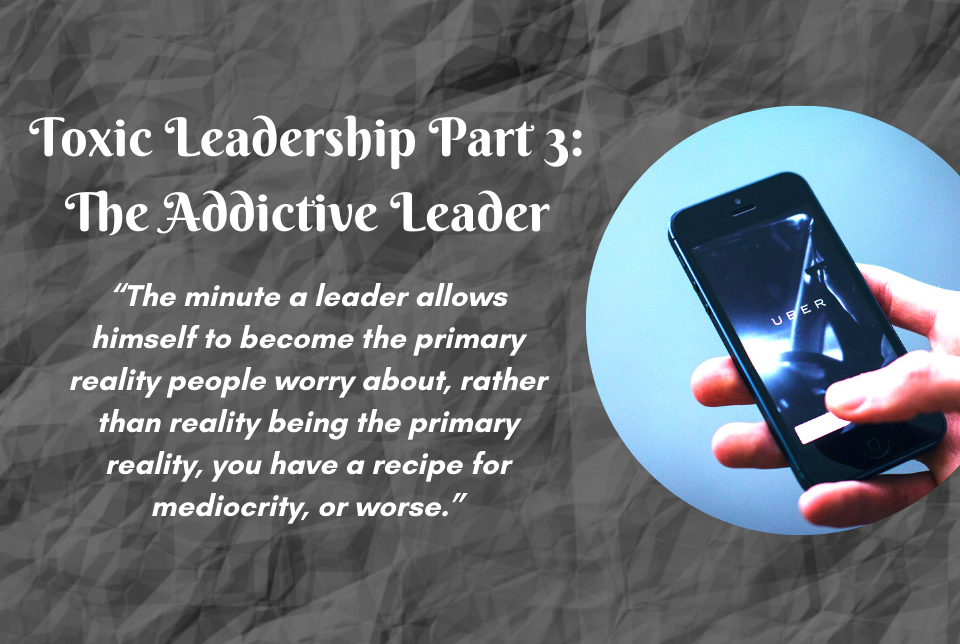Toxic vs. Servant Leadership (Part 2): The Narcissistic Leader
In Part 1 of this series on toxic leadership, we considered the self-focused leader. We saw that the self (vs. other) focus of the leader creates the foundation for a toxic environment as the organization becomes a way to meet the needs of the leader over not just the followers but also the mission and purpose of the organization itself. This mindset choice (others or self) sets the stage for either a healthy or unhealthy organizational culture. An extension of this theme of the self-focused leader is the more dangerous topic of the narcissistic leader.
Narcissism is present when “an individual has an inflated self-view and craves affirmation of that self-view.” These leaders tend to be “excessively confident about their intelligence and judgement and to be arrogant and disagreeable. They also seek continuous affirmation of their inflated self-view by exhibiting their superiority, devaluing others, and reacting aggressively to criticism” (Zhu & Chen, 2015). Have you ever worked for a leader like this? Narcissists will suck all of the attention and energy from a room as they expect everything to revolve around them and that they are the only ones who can fix the problems that we face. 
Yes, narcissists are drawn to leadership roles as they provide for them the high level of affirmation and deference they need. Narcissists may come across as highly competent (and in fact they may be) and they also can come across (for a while) as caring and supportive. But, the driving motivation of the narcissist is to promote and affirm themselves. Leadership is about them and others (including the organization itself) become a means to an end. This leads to unhealthy ways of relating and communicating while everyone works overtime to satisfy the deep needs of the narcissistic leader.
What are the signs of a narcissistic leader?
- A severe lack of empathy; the ability to feel (and care about) what other’s feel. The narcissist is deeply insecure and, in many ways, an empty shell that constantly needs to be filled through the affirmation of others. They can’t feel for others because they lack the inner resources to do so.
- A critical spirit. For the narcissist, your performance is never enough. Nothing is ever enough. Narcissism, especially when wedded to perfectionism, can be highly critical and demeaning toward others. Others are obstacles in the way of the narcissist not partners to be celebrated and affirmed.
- A constant need to be praised. The narcissist demands attention and recognition. Yes, everyone wants to be appreciated and encouraged, but for the narcissist this is a deep-seated need and those who work for this kind of leader are constantly walking on eggshells and living in fear.
- Exploits others for their own personal gain. This exploitation defines autocratic leadership; leaders leading for themselves over others and feeling no shame in using others to meet their own vision for personal success.
So, how do organization get into this mess? Why would anyone select a narcissist to lead them? Often we buy into the myth that in times of great difficulty we need a powerful heroic leader to fix all of our problems.
“When an organization is in deepest despair, there is often a willingness to accept dependence on this kind of powerful leader, but that is a dangerous bargain to make. The narcissistic leader is never satisfied by their latest huge acquisition, or recent praise from subordinates. They always require more. Top leader roles are attractive to narcissistic leaders and they seek them since these positions provide a place where these leaders can meet their self-focused needs and are affirmed as long as they bring success to the organization” (Laub, 2018)
As you read through this you likely have identified in your mind narcissists who are leading in organizations you know. Yes, they are leading now in business, churches, non-profit organizations and politics at the highest levels. In contrast, servant leadership is an approach to leading that puts others first and allows those led to be in the spotlight. The truly humble leader can be as effective or even more effective as the autocratic leader (Collins, 2001 and Sipe & Frick, 2009) while creating an organizational environment that is healthy and long-lasting; a place where people are treated with respect and as partners in the leadership enterprise.
Narcissism or servant leadership? We must identify the toxic nature of much of our leaders today and call out for a healthier, more responsible way of leading.
Your fellow servant,
Jim
James Laub, Ed.D.
jlaub@servantleaderperformance
servantleaderperformance.com
561-379-6010
Laub, J.A. (2017). 40 days toward a servant leader mindset. Jupiter, Florida: Servant Leader Performance.
Laub, J.A. (2018) Leveraging the power of servant leadership: Building high performance organizations. Cham, Switzerland: Palgrave MacMillan.




